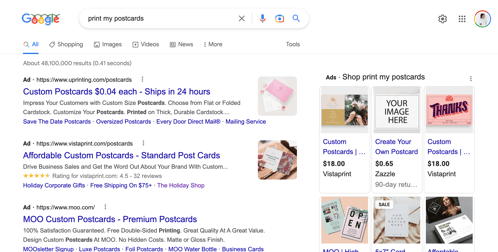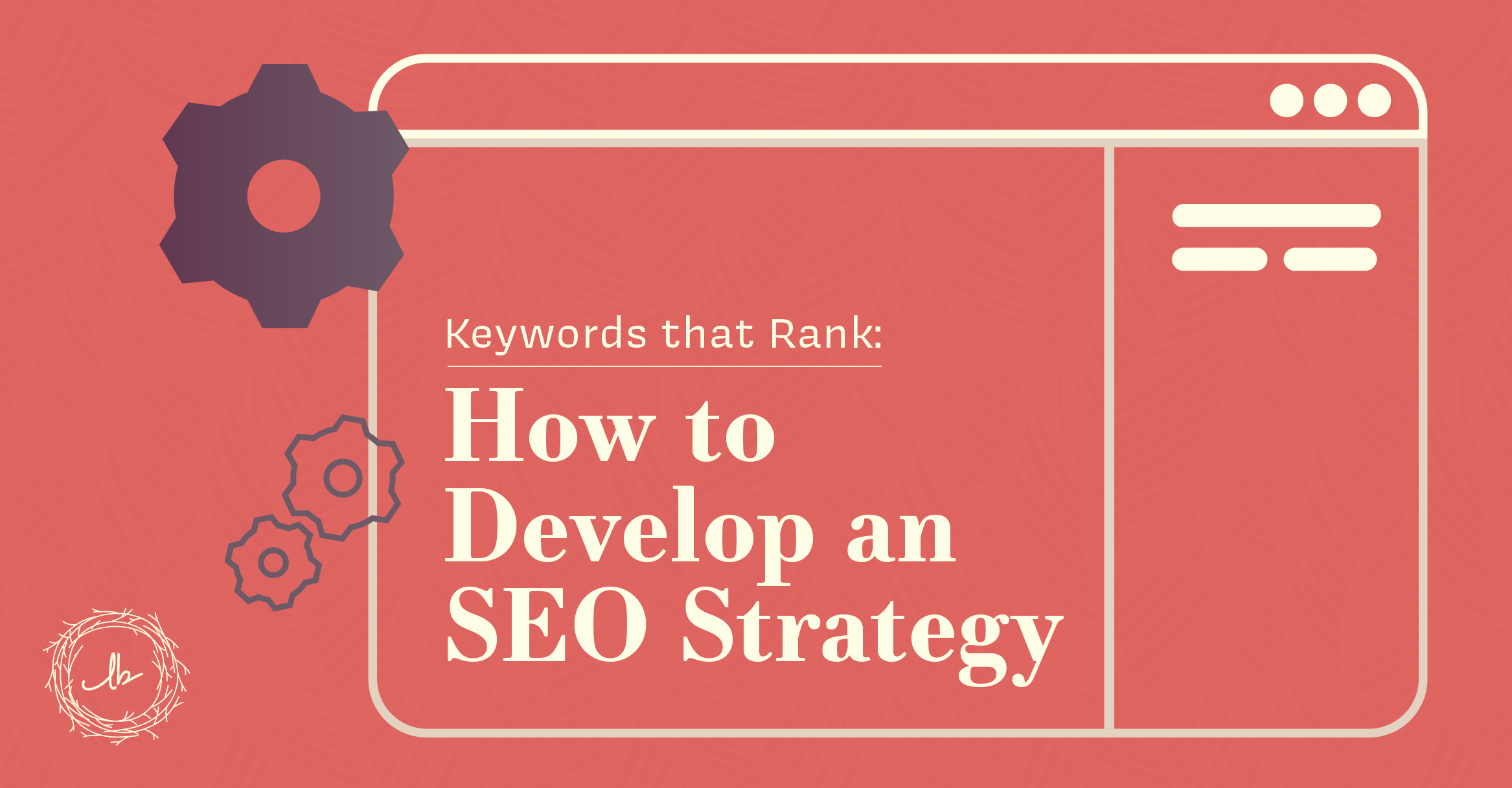Ahhh. That sinking feeling. You check Google search results and your website isn’t on the first page of results… Or the second… Or the third. Actually, that blog post you worked so hard on – about a hot new buzzword topic – isn’t even popping up on the first five pages of search results. Yikes.
First of all, don’t bother looking past page one. Page two of Google is where they bury the bodies. NO ONE ever looks there!
Developing an SEO strategy is key to being found through search engines and increases organic traffic to your website. Of course, you want all your web pages to rank highly in search engine results pages (SERPs), and to be found organically (without paying for ads) by your target audience. While it can feel like swimming upstream against a raging river, SEO is a science that you can master by implementing an SEO strategy that focuses on SEO topic clusters and SEO content strategy.
Get ready to feel like the CEO of SEO.

What is SEO?
Let’s start with the basics. SEO stands for Search Engine Optimization. SEO is the process of acquiring web traffic through the search results on search engines like Google, Bing, etc. The goal of SEO is to improve your website (and website pages) position on the search results pages to increase visibility. As we like to say, “Unseen is unsold.”

How do SEO and SEM relate?
If you’re asking that question: high fives all around!
There is a difference between SEO and SEM. SEM stands for Search Engine Marketing. While SEO is the science of improving website traffic through free and organic methods, SEM is the promotion of your website through paid advertising to get your pages to appear higher in search engine results. An obvious example of SEM is when you Google “business cards” or “print my postcards,” the top results will have a little “AD” indicator on the top left corner of the first few listings. This means that certain businesses have paid Google for that top placement in the results.

But what ranks underneath that is considered “organic” SEO (meaning you don’t pay for it, but it was earned through what you did correctly on your website).
Here’s how we like to explain it – SEM delivers quick wins, while SEO is the long game. Both will bring visitors to your site and should be used in tandem.
For many industries, keywords are expensive and SEM can cost a pretty penny. So let’s dig further into SEO and how you can develop a strategy to put your web pages on the world wide web map without ad spend!
What is an SEO Strategy?
SEO without a plan is like throwing darts at a dartboard in the dark… when you don’t have darts, but only churros to throw. You probably won’t hit anything. Churros are delicious, but that is beside the point.
SEO strategy is your plan to make your web pages rank higher on search engines. There’s only one small caveat. The search engine algorithms change. Remember what we said about throwing churros in the dark?
Well, it’s a good thing we believe in the science of SEO strategy because regardless of how algorithms change there are a few failsafe methods.
 Changing algorithms also means that you can’t “set it and forget it.” An SEO strategy involves analysis, course corrections and keeping an eye out for the latest developments and changes in search engine algorithms. As in science, there is continual experimentation to uncover the underlying truths about how search engines are analyzing what humans put on the web in an attempt to order it and feed it back to us when and how we want it.
Changing algorithms also means that you can’t “set it and forget it.” An SEO strategy involves analysis, course corrections and keeping an eye out for the latest developments and changes in search engine algorithms. As in science, there is continual experimentation to uncover the underlying truths about how search engines are analyzing what humans put on the web in an attempt to order it and feed it back to us when and how we want it.
Is SEO really that important?
Ummm. Well, how often do you pick up a phone book to decide which restaurant to eat at? Or which electrician to hire? Never?
Have we mentioned that we like to say, “Unseen is unsold”?
That’s precisely why SEO is that important. It’s the number one way people will find your business. While SEM can be an effective part of an online strategy, SEO is even more important for the vast majority of brands and businesses out there because it is a longer play – earned media can have a long shelf life if it is done correctly. In fact, despite billions of dollars spent on SEM and other online ads, in 2022, 53% of all website traffic was organic.
Imagine what being in that first spot on the search results would do for your business.
How to Make an SEO Strategy
Before we get into the details, here’s a brief list of SEO best practices every marketer should follow:
- Make a list of topics you want to be famous for.
- Make a list of long-tail keywords based on those topics.
- Consider a long-format web page for each topic.
- Start a blog and implement a content writing strategy for each article.
- Create a link-building plan (don’t forget to link to other content within your own website).
- Keep an eye out for SEO changes, news, and best practices (be ready to pivot).
- Measure and track your SEO success.
With that basic outline in mind, let’s go a little deeper.
The Three Types of SEO
Wait, wait, wait. There are three types of SEO?

Yeah, we see you. Don’t worry – this is actually a good thing. Hang in there.
SEO #1 - On-Page SEO
On-page SEO hinges upon the content that is on the website pages themselves. This is optimized by using keywords effectively within a content strategy.
SEO #2 - Off-Page SEO
Off-page SEO hinges upon all the links that point back to your website from other sources and spaces on the internet. These links are called “backlinks” or “inbound links” as they link back to your website. Backlinks from reputable sources help your website to garner trust with the algorithms.
SEO #3 - Technical SEO
Technical SEO hinges upon the backend of your website, including images, alt text, metadata and the site code. Search engines actually care about the technical set-up of your website, and uses the backend as a factor when considering the position of your web page rankings.
The steps in your SEO strategy should incorporate each of the 3 types.
Step 1: Make a List of Core Topics
Who doesn’t love a good list?
Whether it’s a grocery list, a to do list or a topic cluster list for SEO, we like lists! Your list of topics should include all the things you’d like people to find you for or associate with your business. Try to find about 10 words or terms. If you don’t know where to start, consider using an SEO tool like Google Keywords.
By utilizing search volume and keyword difficulty as your measurement, your list will not just be randomized ideas but strategic keywords varying in difficulty that will become the “pillars” of your website.
Step 2: Research and Assemble Keywords Based on Topics
Now that you have your targeted list of core topics,, let’s dig a little deeper and find keywords that relate to each.
This list should be composed of both short and long-tail keywords.
What are short-tail keywords? A short-tail keyword is a general search term that generally is composed of just 1 to 3 words and is about a broad topic. Usually, short-tail keywords have much higher search volume compared to long-tail keywords. Translation? More website traffic.
What are long-tail keywords? They are key phrases that are generally between three to five words. They are more specific than your pillar keywords and receive less “queries” in search engines. However, these long-tail keywords are veritable gold when you want to reach your target audience.

If your pillar word is “SEO,” then a long-tail keyword might be “SEO content writing tips.” Think about how hard it would be to rank for one word like “pizza” out there on the internet! That’s a lot of competition. Ranking for “best pizza in San Rafael” will be less competitive, thus easier.
As you choose topics and build pages, remember that for search engines, talking about one topic 12 different ways is better than talking about 12 different topics once. You might get tired of talking about your key differentiation, area of expertise or star product, but writing about the same thing six ways til Sunday is a sure way of proving to search engines that you are indeed the expert and authority on the matter.
Step 3: Build Web Pages Based on Each Topic
 This is where an SEO content strategy really comes to life. Create a web page based on each keyword topic, and the associated keyword cluster with the long-tail keywords. Make this a high-level overview of the topic. Ensure that you have links, both external and internal, as well as optimized images with titles that use the keywords, and alt text and metadata/descriptions that use them as well. Generally speaking, the longer the webpage, the better. Google now scans webpages similarly to a human being – if you’re “stuffing” your pages with keywords but really saying nothing useful, Google will recognize this behavior and will devalue the content.
This is where an SEO content strategy really comes to life. Create a web page based on each keyword topic, and the associated keyword cluster with the long-tail keywords. Make this a high-level overview of the topic. Ensure that you have links, both external and internal, as well as optimized images with titles that use the keywords, and alt text and metadata/descriptions that use them as well. Generally speaking, the longer the webpage, the better. Google now scans webpages similarly to a human being – if you’re “stuffing” your pages with keywords but really saying nothing useful, Google will recognize this behavior and will devalue the content.
This is how we all work humanly. We all ignore that jerk at the cocktail party who won’t stop name-dropping. We think it’s annoying. Google does too. Write with your keywords but also write with the purpose to bring value to your readers.
Step 4: Start a Blog and Implement Content Writing Strategies
Creating fresh content keeps your website fresh. And Google loves freshness (yes, that’s a technical term). While it may sound like we’re joking, we’re completely serious about the process. Google gives bonus points to websites that are up-to-date and continually generate fresh content or rework previous pages and posts.
Search engines don’t want to find a page that is 5 years old and hasn’t been touched since; They want to find the latest and greatest out there. That’s why having a consistent blogging schedule works in your favor. Besides, writing a new blog makes a lot more sense than rewriting your homepage each week!
Just remember, whatever you write, make sure that you’re writing it for most ideal clients, not writing for search engines. Write about topics they are interested in that can showcase keywords and not the other way around.
Step 5: Create a Link-Building Plan
The more “authority” a website has, the better. There’s an actual metric out there called DA (Domain Authority) that is used to rank entire websites to rate/grade websites. While it may sound lofty, you probably have a better sense of it than you think. The more recognizable or well-trafficked a website is, the higher the authority will be. For example, consider how much traffic Forbes gets for searches about “business news” as opposed to the Indianapolis Business Journal. One site is clearly more trafficked than the other.
This is why you need to create a plan for attracting more backlinks to your website from other websites, pages and sources on the world wide web. As you create a backlink plan, consider contacting other partners or brands to see if you can swap web page links, or write a few guest blog posts that link back to your website. This can be as simple as organizations or associations you belong to that link back to your site in their membership listing. It is worth noting as well that you need other authoritative websites to link back to yours. If a spammy website gives you a backlink, Google will penalize you.
All that being said, the Indianapolis Business Journal serves a niche in the Indiana area. It’s nothing to sneeze at either! We mean no disparagement.
Step 6: Keep an Eye Out for SEO Changes, News and Best Practices
The SEO space isn’t static. Keep an eye out for changes to search engine algorithms. A small switch could provide your business with a fantastic opportunity! Look through current blogs on the subject from authorities like Hubspot or Moz. We also highly recommend The Orbit Blog by our lovely friend Andy Crestodina at Orbit Media Studios. We think he is the shit when it comes to SEO.
See what we did there? We love him so much we gave him 3 unsolicited backlinks.
He’s worth it.
Step 7: Measure and Track Your SEO Success
Clearly, a lot of work goes into SEO strategy and implementation. And after all that hard work, don’t kick back and relax in a bubble bath of complacency. The bubble bath is fine, but NO COMPLACENCY.
A web analytics tool can help track indexed pages and monitor SERP rankings. \Reporting also allows you to effectively measure the amazing progress you’re making, and spot SEO opportunities as they arise.
If all of that makes you groan and your eyes glaze over, just contact us and we’ll get this going for you. But what is important, even if you have an expert do it for you, is that you understand the importance of SEO and level of commitment needed to maintain a working strategy.
SEO for Lead Generation
Now that you know how SEO works and how to go about building an SEO strategy, we would be remiss if we didn’t discuss SEO for lead generation. As organic search is king on the internet, SEO is the kingmaker of your digital marketing strategy. By writing relevant, useful, engaging content, you’re not only providing your potential clients with something they need, but you are matching your website with customer intent.
You know what that means? Higher quality leads.
And, as you’re not stuck in the pay-per-click (PPC) world of SEM, your cost per conversion can be significantly lower (and continue to decrease over time).
Already have an SEO strategy in place?
If you already have a strategy in place, but want to level up your SEO game, start by performing an SEO audit. You’re welcome to hire an expert to do this for you, as these audits require review of page factors, content organization, image quality, back-end website architecture (like schema and mark-up), quality of inbound links, etc. If you want to do a DIY SEO audit, there are excellent roadmaps out there like this one.
After an audit is complete, you’ll want to define your key performance indicators (KPIs). Some examples include monitoring keyword ranking, bounce rate, organic sessions, leads and conversions. After you choose KPIs, then comes the keyword research. Yes, research should be done annually. Don’t skip doing a fresh research session to get a pulse on how certain keywords are performing.

BONUS PART 1: Take Your Keyword Research to the Next Level
Keyword research isn’t just plugging in a word or phrase and glancing at the results. As language is rich and complex, so are keywords. You’ll want to make sure that you’re considering not just the keyword itself but also possible variations of the keyword – this is especially useful with long-tail keyword phrases ( i.e. “the price of gas” could also be “the cost of gas”).
After you have a list of keywords and have reviewed the search volume, value and competitiveness, here’s where the rubber meets the road.
BONUS PART 2: Funnel Keywords
Make sure that you’re using keywords that target your potential customers at all stages of the buyer’s journey funnel – awareness, consideration, and decision. Keep in mind that people at the top of the funnel in the awareness stage are more likely to search for general terms (or symptoms), whereas people further along in the funnel are going to get more specific (searching for remedies and solutions). You want to have pillar pages and blog posts that focus on all stages of the buyer’s journey to make sure you’re capturing and nurturing quality leads, no matter where they’re at in the funnel.

You’ve earned it! It’s SEO party time. While we wish that following this optimization guide will deliver overnight results, that’s not the case. SEO takes time. Set realistic expectations. Do your part to implement an SEO content strategy that will slowly work to gain search engines’ attention, and then, eventually, their trust.
Just as you’re winning over clients and clicks, you also have to win over the search engines. They might be AI robots, but they are smart AI robots that need you to follow their rules so they can treat you right.
Don’t let the fun stop now! Snag our free SMART goals resource to get planning.





Let Us Know What You Thought about this Post.
Put your Comment Below.